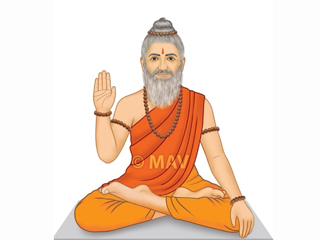#Datta Datta #ShriDatta ShriDatta #mahalaya mahalaya #pitrupaksha pitrupaksha #shraddha shraddha #ShraddhaRituals Shraddha rituals #Shraddhavidhi Shraddha vidhi
Contents
1. Information related to the term ‘Shraddha’
2. ‘Shraddha’ means not just ‘remembering ancestors with a sense of gratitude’, but is also a ritual to be performed
3. Historical details of the ritual of Shraddha
4. Three historically established phases of Shraddha and its nature in the current era
1. Information related to the term ‘Shraddha’
A. Meaning and Scope
The term ‘Shraddha’ has originated from ‘Shraddha’ (faith). It is impossible to repay the various favors, which our deceased forefathers have done for us. The ritual performed for them with complete faith is known as Shraddha.
B. Definition
The definition of Shraddha as given in the ‘Shraddha’ chapter within the Brahmapuran Holy text is as follows :
देशे काले च पात्रे च श्रद्धया विधिना च यत् ।
पितृनुद्दिश्य विप्रेभ्यो दत्तं श्राद्धमुदाहृत् ।। – ब्रह्मपुराण
Meaning : The offerings (food etc.) made to the brahmins (priests) with the intention of being received by the deceased ancestors, after taking into account the aptness of country, time period and place and with complete faith and abiding by all the rules is known as Shraddha.
C. Associated words
Shraddhattva Pinda, Pitru Puja (ritualistic worship of deceased ancestors), Pitru Yagna (sacrificial fires performed for deceased ancestors)
2. ‘Shraddha’ means not just ‘remembering ancestors with a sense of gratitude’, but is also a ritual to be performed.
3. Historical details of the ritual of Shraddha
A. The original concept of performing the ritual of Shraddha was concieved by Sage Atri, the son of Deity Brahma. Sage Atri narrated the ritual of Shraddha as laid down by Deity Brahma to Nimi from his lineage. This established ritual has continued even today.
B. Manu was the first one to perform the ritual of Shraddha. Hence he is called the Deity of Shraddha.
C. After Shriram, Sita and Lakshman left for their stay in forest, Bharat met them in the forest and apprised them about the death of their father. The epic Ramayana mentions that Shriram later performed the ritual of Shraddha for His deceased father at an appropriate time.
4. Three historically established phases of Shraddha and its nature in the current era
A. Agnoukaran
During the era of Rugveda, deceased ancestors were worshipped by offering Samidha (a kind of wooden stick) and Pinda (a rice ball) to the sacrificial fire.
B. Pindadaan (worship of Pinda)
The process for Pindadaan is mentioned in the holy scripts of Yajurveda, Bramhane, Shrout and Gruhya sutra. The ritual of Pindadaan was put into practice during the period of Guhya sutra.
The information regarding the time period when the worship of Pinda started is documented in the holy text Mahabharata (Shantiparva 12.3.345) – Varaha, incarnation of Vishnu, introduced Shraddha to the entire world. He created three Pindas from His molar tooth and placed it on a Darbha (dried grass twig) towards the southern direction. Varaha advised ‘Let the 3 Pindas be considered as a representation of the father, grandfather and great grandfather’ and then He vanished after performing the ritualistic worship of the Pindas using sesame seeds in a scientific manner. Thus began the worship of Pinda for deceased ancestors as per the guidance of Varaha.
C. Offering food to priests (Brahmins)
During the post-Gruhya sutra and Shruti-Smruti period, offering food to priests (Brahmins) was considered mandatory and became an important part of the ritual of Shraddha.
D. All the three phases together
In the current era, all the three phases mentioned above are included within the ‘Parvan’ Shraddha. The science of Dharma prescribes that householders should perform the ritual of Shraddha as their duty.
Reference: Sanatan’s Holy Text ‘Shraddha(importance and scientific explanation)’

 One Lamp for Hindu Rashtra: a unique initiative by Hindu Janajagruti Samiti on Tripurari Purnima
One Lamp for Hindu Rashtra: a unique initiative by Hindu Janajagruti Samiti on Tripurari Purnima British Prime Minister’s Office apologises to Hindus
British Prime Minister’s Office apologises to Hindus Diwali celebrations held at Capitol Hill following the recent presidential election in the United States
Diwali celebrations held at Capitol Hill following the recent presidential election in the United States Punjab CM Maryam Nawaz celebrated Diwali in Pakistan
Punjab CM Maryam Nawaz celebrated Diwali in Pakistan Diwali celebration in the Parliament of Canada is not banned : Clarification by the Opposition
Diwali celebration in the Parliament of Canada is not banned : Clarification by the Opposition Unique research on the effect on Apta leaf (Mountain ebony) on the day of Dussehra !
Unique research on the effect on Apta leaf (Mountain ebony) on the day of Dussehra !